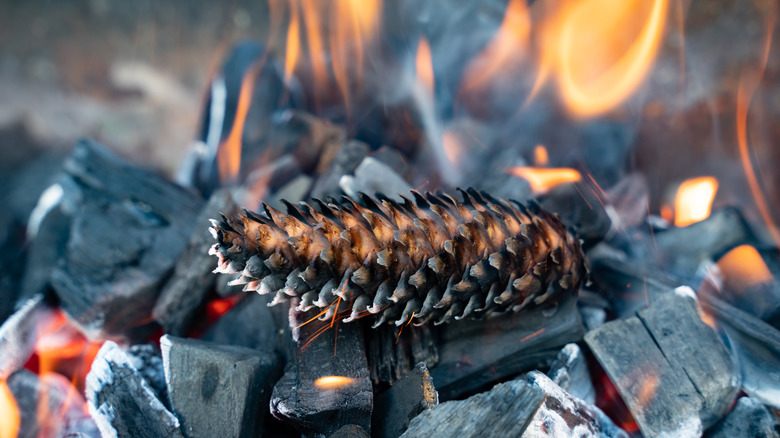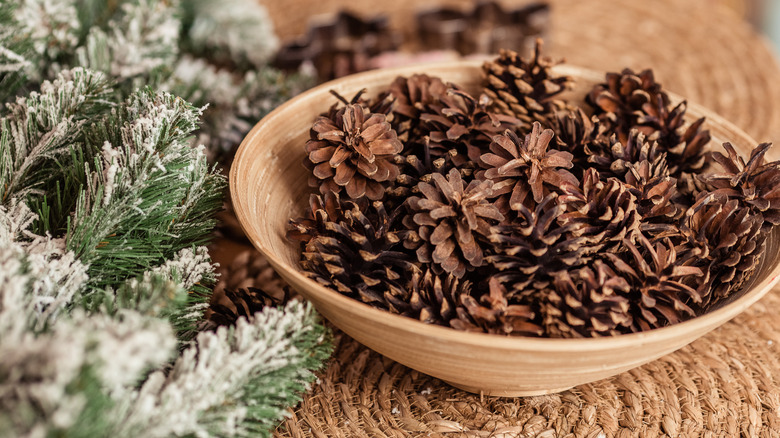All The Useful Ways You Can Use Pinecones In The Garden
If you have pinecones strewn across your yard, you'll be pleased to discover that rather than a mess, you actually have a goldmine. That's because pinecones, a type of gymnosperm, are resistant to mold and fungi, making them an excellent choice to use in and around the garden. They can be used for everything from improving soil drainage to providing food for wildlife. Parents will also want to involve their kids in many of these activities, as the act of gathering and repurposing pinecones is quite fun.
There's no need to fret if your property is devoid of pine trees, however. Pinecones are actually available for purchase at many garden centers and farmers' markets, as well as online from sites like Amazon, Etsy, and eBay. Of course, you can always grab a basket and go foraging for free pinecones along a woodland trail or within a local park. Then take your basket back home and begin using this natural resource to make improvements throughout your garden.
Attract birds by creating a pinecone bird feeder
Attracting birds is an excellent way to help a garden thrive, as birds not only assist in pollinating plants but also dine on pests and help control weeds. One way to attract birds is to create a bird feeder. Pinecones can easily be transformed into bird feeders. So, grab your binoculars and an illustrated field guide and get ready to admire all of the different species of feathered creatures that visit your property.
Gather one pinecone for each bird feeder you'd like to make. Attach a piece of string or yarn to the stem of the pinecone. The length should be determined by the diameter of the branch, hook, or pole that you plan to use when hanging the bird feeder. Next, cover the pinecones with peanut butter. A basting brush works well for this. Finish by coating the bird feeders with wild bird seed. Once the birds have finished feasting on the seeds, the natural bird feeder can be tossed into a compost pile. There's no waste with this craft!
Provide a habitat for beneficial bugs
Many insects are actually beneficial to a garden. Lady bugs, lacewings, and ground beetles all dine on aphids, which weaken plants by sucking out their nutrients. Keep in mind, the more pests you can control naturally, the less likely you are to need harsh chemicals, such as those found in many insecticides. One way to attract helpful bugs is to create a pinecone habitat.
Erecting a shelter for beneficial insects should begin with a roof, as bugs enjoy hiding within the open scales of a pinecone. However, those scales won't remain open if they get wet. So, take two flat pieces of wood, metal, or tile and set them together at the ends to form a triangular roof. If the pieces won't stay together on their own, you can use a little super glue. Place several pinecones underneath the roof. Try to interlock some of the scales to help hold the pinecones together. Then, add a few twigs and leaves in some of the open spaces, and you're all done!
Add drainage to your garden planters
Proper drainage is important for plants and flowers to thrive in garden planters. When water is allowed to keep soil in a soggy state, it begins to lose oxygen, as well as giving roots the ability to actually drink the water. This not only causes the flowers to wilt and turn yellow, but it can also lead to fungal diseases, like root rot. One way to provide excellent drainage is to fill the planter's base with pinecones.
Clean the planter you'd like to use and then place enough pinecones inside to reach about halfway up. Choosing pinecones of a larger size with scales that are farther apart is best, as this allows for maximum drainage. You'll notice this method also requires less soil, as the pinecones fill a considerable portion of the container. That means you'll save money while also improving the health of your foliage and blooms.
Create a natural mulch
Mulch provides a variety of benefits for home gardens, in addition to contributing to the overall appeal of the space. It suppresses weeds, reducing the amount of time you need to work in your garden. Mulch also insulates the soil, keeping roots warm in the winter, and retaining moisture, preventing water from evaporating under the sun's hot rays. Pinecones are an excellent free resource that can be used to create a natural mulch, which is always a better option than costly synthetic alternatives.
There are actually two ways you can go about using pinecones as mulch. You can spread the pinecones across your garden unaltered, or you can rent a wood chipper from your local home improvement store to create a more traditional ground mulch. A good rule of thumb is to keep the layer of mulch around 2 to 3 inches. As the pinecones begin to decompose, you can rake the mulch and add a little more.
Design an attractive accent using pinecones
Whether you're looking to define a pathway through your garden or create edging around a set of plants, pinecones have you covered. They are quite attractive as-is. However, they can also be dried out and painted to provide a touch of elegance or a big pop of color to your outdoor space.
After gathering the amount of pinecones needed for your specific project, bake them on a lined cookie sheet for 20 minutes at a temperature of 200 degrees Fahrenheit. This process gets rid of any sap, as well as any bugs that may be hiding among the scales. Wait for the pinecones to cool completely before painting them.
There are several ways one can go about painting pinecones, and the method you choose will depend on your project. For example, a paintbrush can be used to give the pinecones white tips to achieve a snowfall effect. Spray-painting the cones silver creates an elegant look. There's also the option to completely coat the pinecones in a variety of colored paints to really brighten up your space. Allow the paint to dry before using the pinecones to decorate your garden.
Prevent soil erosion
Sloped areas within a garden are susceptible to soil erosion. When heavy rainfalls arrive, water slides down the slope, taking some of the soil along with it. Over time, this can become a real problem for your landscape. One way to combat soil erosion naturally is to cover the sloped area with pinecones.
Mulch itself can do an excellent job of preventing soil erosion. However, pinecones have an added benefit above other options. These organic gems are coated with a resin that repels water. Since the pinecones also have open scales, the wind can pass through freely, reducing erosion that often occurs from strong breezes. To protect your soil, distribute the pinecones across the slope in your garden at a thickness of 2 to 3 inches. Once you have the pinecones where you need them, cover them with a net. The net can be removed once all of the pinecones have stabilized.
As a fire starter for your fire pit
There's nothing more relaxing than gathering around a backyard fire pit with friends and family during those crisp fall and spring evenings. When preparing the fire, it's helpful to use a fire starter. Fortunately, the abundance of pinecones decorating your yard can be collected and used to create free fire starters that can result in beautiful flames. Plus, you can customize them to change the color of the flames for an enhanced experience.
First, use a double-boiler to melt some beeswax. Dip your pinecones in the wax one at a time, then set them aside to cool on a piece of parchment paper. Give each pinecone a second coating of wax, but this time immediately sprinkle a little salt over it so that it sticks when the wax hardens. Table salt produces a yellow flame, while Epsom salt turns the embers white. If you have calcium chloride on hand to melt ice, you can use that to achieve an orange flame. You can even use Borax to make yellowish-green flames. Depending on the size of your fire, toss three to five pinecone fire starters in your pit to get the blaze going.
Add a pleasant scent to your garden space
Although pinecones themselves can be used to add a woody scent to your garden space, there's also the option to infuse them with essential oils. This allows you to create a pleasant aroma in your outdoor areas without the use of harsh chemicals. If you also have a few insect pests you need to eliminate, you can choose an essential oil that doubles as a natural insect repellent.
Gather a basketful of pinecones and then preserve them by drying them out. The fastest way to do this is to bake them at 200 degrees Fahrenheit for 20 minutes. Once the pinecones have cooled, you can place them in a sealable plastic bag along with 30 drops of your desired essential oil. Cinnamon essential oil works well in the fall, while rose essential oil is more suited to spring. A few options that repel insects include eucalyptus, bergamot, peppermint, and lavender essential oil. After applying the oil, shake the bag and set it aside for seven days to fully absorb the scent. Place the pinecones in a few decorative bowls and then set them throughout your garden.
Create markers for your plants
Whether you're just starting out landscaping your yard or simply creating a new space within your garden, it is easy to quickly forget which flowers or vegetables are planted where. That's where plant markers come into play. They can provide a quick way to identify which seeds are hidden beneath the soil. Did you know you could make your own garden planters using pinecones?
Gather one large pinecone for every garden planter you need. Drill a small hole no deeper than 1/8th of an inch into the base of each pinecone. Then, place a dab of hot glue on the end of a skewer and push it up into the hole. Hold the skewer in place for half a minute so the glue has time to harden. Next, create your identification labels by either painting pictures of the type of plant on a sheet of paper or by writing out the name of the plant using a permanent marker. Have the paper laminated to protect the image/word from rainfall.
Wedge the bottom of the label into one of the pinecone's top scales. Add a dab of hot glue to secure it in place if you don't get a tight fit. Then, push the bottom skewer down into the ground in front of the row of plants you need to identify, and you're all set!
Grow new pine trees
Is your garden lacking shade or privacy from nearby neighbors? Adding pine trees to your landscape can solve both of these issues. There's no need to pay money to purchase starter trees either, as you can grow new pine trees using freshly gathered pinecones.
Grab a basket and set about harvesting pinecones that are still closed, as this means the seeds are still inside the cone and have not yet been released. Drop the pinecones in a paper bag and set them in a location that receives plenty of heat. Heat causes the scales to open and disperse the seeds. Then, transfer the seeds to a plastic bag and set them in your freezer for 90 days. Fill small pots with well-draining potting mix and then plant one seed in each one. Give the seeds plenty of light and keep the soil moist to the touch. Transplant the pine trees to their designated outdoor location after they have reached a height of 8 inches.










